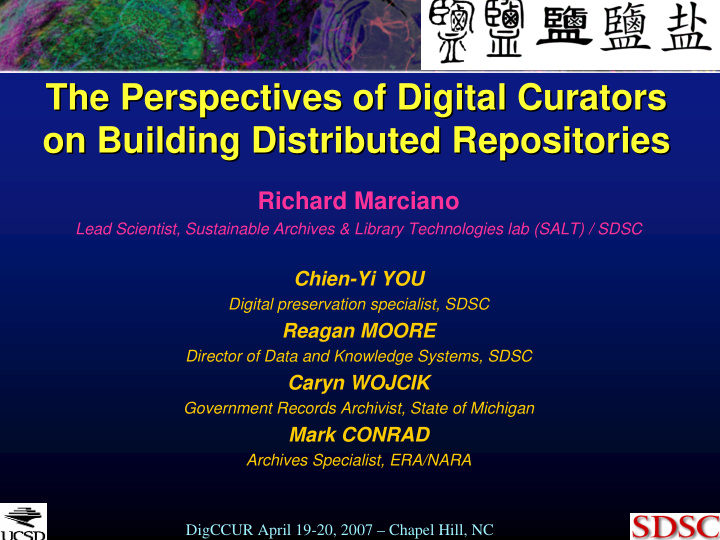



The Perspectives of Digital Curators The Perspectives of Digital Curators on Building Distributed Repositories on Building Distributed Repositories Richard Marciano Lead Scientist, Sustainable Archives & Library Technologies lab (SALT) / SDSC Chien-Yi YOU Digital preservation specialist, SDSC Reagan MOORE Director of Data and Knowledge Systems, SDSC Caryn WOJCIK Government Records Archivist, State of Michigan Mark CONRAD Archives Specialist, ERA/NARA DigCCUR April 19-20, 2007 – Chapel Hill, NC
Recent Collaborations on Preservation Recent Collaborations on Preservation (NARA, NHPRC, LOC, NSF, IMLS) (NARA, NHPRC, LOC, NSF, IMLS) NARA: 1998-2007, NARA - U Md, GTech, SLAC, UC Berkeley Transcontinental Persistent Archive Prototype based on data grids. IP2: 2002-2006, NHPRC/SSHRC/NSF - UBC and others. InterPARES 2 collaboration with UBC on infrastructure independence PERM: 2002-2004, NHPRC - Michigan, SDSC Preservation of records from an RMA. Interoperability across RMAs. LoC: 2003-2004, LoC - SDSC, LOC Evaluation of use of SRB for storing American Memory collections ICAP: 2003-2006, NHPRC - UCSD,UCLA,SDSC Exploring the ability to compare versions of records, run historical queries A&W: 2000-2003, NHPRC - SDSC Methodologies for preservation & access of software- dependent electronic records DIGARCH: 2005-2007, NSF - UCTV,Berkeley,UCSD Libraries,SDSC Preservation of video workflows eLegislature: 2005-2007, NSF - Minnesota, SDSC Preserving the records of the e-Legislature VanMAP: 2005-2006, UBC - UBC,Vancouver Preserving the GIS records of the city of Vancouver eLegacy: 2006-2008, NHPRC - California Preserving the geospatial data of the state of California T-RACES: 2006-2008, IMLS - UCHRI,SDSC California's redlining archives testbed PAT: 2004-2007, NHPRC - Mi,Mn,Ke,Oh,Slac,SDSC Demonstration of a cost-effective system for preserving electronic records.
Project Summary Project Summary • Participants were digital curators from: • Libraries / archives / historical societies / scientific data environments / museums • IT researchers and staff • Main Goal: • Design a distributed repository for electronic records management • Demonstrate the management of various types of records with a common software infrastructure • Approach: each site… • chose an archival collection • set up access control and update permissions for their preservation environment independently of the other participants • implemented a different preferred interface for interacting with their archival collections
Presentation Goals Presentation Goals • Comments: • “No repository is an island”, David Giaretta • … PAT fits the archipelago model • Examine: • lessons learned and skills needed by digital curators to automate archival functions: appraisal, accessioning, arrangement, description, preservation, and access of records. • benefits achieved by using common infrastructure
Partners Partners
PAT Project PAT Project • Test a community model for electronic records management, with archival and technological functions in a distributed network (using the SRB: Storage Resource Broker – data grid technology) • Initial Test sites: (1) Michigan Department of History, Arts and Libraries , (2) Ohio Historical Society , (3) Kentucky Department for Libraries and Archives , (4) Minnesota Historical Society , (5) SLAC Stanford Linear Accelerator Archives and History Office . Participants: (a) California State Archives (b) Kansas State Historical Society (c) University of Illinois Urbana Champaign (d) University of California Los Angeles (UCLA): (e) Yale Manuscripts and Archives (f) Georgia Tech Observers: (a) Getty Research Institute
PAT Community Grid PAT Community Grid Local Storage Resources Kentucky Michigan Minnesota Ohio SLAC Grid Brick Grid Brick Grid Brick Grid Brick Storage SDSC Archive Archival Storage Metadata Catalog MCAT (HPSS, Sam-QFS) (Oracle) Shared Preservation Environment
Automating Archival Processes Automating Archival Processes Kentucky Michigan Minnesota Ohio SLAC Web RMA -Precinct Spatial E-mail Documents Results DB X Appraisal Accession X X X Arrangement X X X X X X X X X Description Preservation X X X X Access X X X X
Unique Contributions of the Digital Unique Contributions of the Digital Curators to the Infrastructure Curators to the Infrastructure • Windows-based SRB clients / servers • Development of a Perl for Windows client library • Bulk operations were developed, tested, and refined (registration, accessioning, metadata extraction from records, metadata loading, validation of data movement into/out of/within the system) • End-to-end workflows were developed (accessioning, replication) • SRB bugs revealed: better reliability • MCAT ported to mySQL (Oracle, DB2, Sybase, Informix) • Development of a wiki for documentation • Registration of filenames with unusual characters discovered and fixed • Suggestions on ways to simplify governance issues tied to particular types of data management: • Need to express such policies as rules to be applied to the data mgt. system • Development of the next generation of data grid technology: iRODS (integrated Rule-Oriented Data System) • Each preservation process is express as a set of micro-services (operations that can be performed using a remote storage system access protocol)
What Digital Curators Liked… … What Digital Curators Liked • Leverage common software and hardware • Use commodity storage hardware • Lower the cost of participation • Reduce the level of expertise required at each site • Focus on management of the archival collections and outsource the details of the archival repository • Automate the manipulation of collections to minimize the level of effort
Conclusions Conclusions • PAT suggests that sustainability is probably beyond the capability of most individual archival repositories (cost of tracking new types of technology, expertise required to manage new technology, costs of the storage systems and databases, expertise necessary to manage multiple types of storage systems) • Outsourcing of the mgt. or records is feasible through use of data grid technology • Preservation environments can be assembled by creating regional community archival partnerships with university data centers • Independence can be maintained: • Service agreements for storage and preservation or archival e-records are needed
The Michigan example: The Michigan example: • Preservation of historical election data for the state of Michigan: precinct-level election data • Process: from tape to archive to web…
Before Before Karyn Wojcik
Karyn Wojcik
After After Karyn Wojcik
Karyn Wojcik
Karyn Wojcik
For More Information Richard Marciano marciano@sdsc.edu 23
Recommend
More recommend